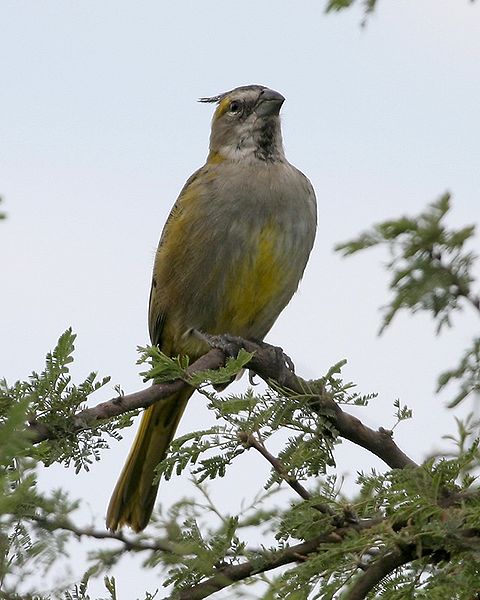Please see Part 1 of this article for information on the natural history and care other South American Cardinals. Today we’ll take a closer look at a species that is much sought-after by experienced aviculturists, the Green or Yellow Cardinal, Gubernatrix cristata.
Range and Status
 The Green Cardinal departs from the usual red/black cardinal color pattern, being strikingly clad in yellow-olive and black and sporting a long, bushy black crest and black bib.
The Green Cardinal departs from the usual red/black cardinal color pattern, being strikingly clad in yellow-olive and black and sporting a long, bushy black crest and black bib.
It was once found in open woodlands and savannas throughout much of Argentina and Uruguay, and in parts of Brazil. Populations have now declined drastically due to over-collection and the conversion of its habitat to cattle pastures and Eucalyptus plantations. The Green Cardinal is also known to interbreed with the Diuca Finch (Diuca diuca). As this finch is much more common than the Green Cardinal, it is expected that continued hybridization may dilute the cardinal’s gene pool and place the species at further risk.
Today the Green Cardinal is found in only a few areas of Argentina (i.e. near Buenos Aires) and is likely extinct in Brazil. The Uruguayan population is estimated at less than 300 birds. Fortunately, it breeds well in private collections, and is also being reared by wildlife agencies throughout its former range. It is listed on Appendix II of CITES.
Captive Accommodations
Green cardinals are quite active, and are best housed in an outdoor aviary or bird room. They are fairly cold-hearty, but cannot abide damp conditions…a warm, dry shelter is needed during the winter in temperate regions.
Green Cardinals get along well with Whydahs, Java Rice Birds, Weavers and similar finches and softbills, although mated pairs can be somewhat aggressive when nesting. In zoo exhibits, I’ve had them chase off Sun Bitterns that ventured too close, but they did not harass the intruders once they moved off.
Breeding
Breeding is likely if the birds are properly housed and fed well (please see below). Green Cardinals prefer to nest in a bush with dense foliage, but will sometimes accept an open-fronted nest box.
The chicks should be removed once they have fledged and are no longer being fed by their parents, lest they be driven off by the male. In most locales, 2 clutches per season may be expected.
Diet
In common with many predominantly seed-eating birds, Green Cardinals will thrive on a rather simple diet. However, a rich, varied diet is a must if they are to achieve breeding condition and remain in good color.
The base of the diet can be comprised of a mix of Finch Seed/Dehydrated Fruit, Parakeet Seed and a small amount of high-quality Wild Bird Food.
Softbill Diet, fresh sprouts, Egg Food, live insects (mealworms, crickets, waxworms and wild-caught moths, beetles, grasshoppers, etc.), Canned Insects, fruit tree buds and fresh greens (i.e. kale, dandelion) should also be provided regularly. Grit and cuttlebone should always be available.
High protein foods are particularly important in bringing the birds into breeding condition, and insects are essential in the successful rearing of chicks. Pairs kept in outdoor aviaries no doubt benefit greatly from the insects that find their way into the enclosure.
Further Reading
Video of captive Green Cardinals feeding their chick.
Read more about the Green Cardinal’s natural history here.
Yellow cardinal image referenced from wikipedia and originally posted by Lip Kee Yap and Snowmanradio
 That Bird Blog – Bird Care and History for Pet Birds
That Bird Blog – Bird Care and History for Pet Birds




some of your south american green cardinals have been spotted in Poteet Texas. none of us had ever seen any before and had no idea where they came from. is it possible a private collector turned them loose in that dry, arid area? several are coming to my friends bird feeder outside of Poteen, Texas.